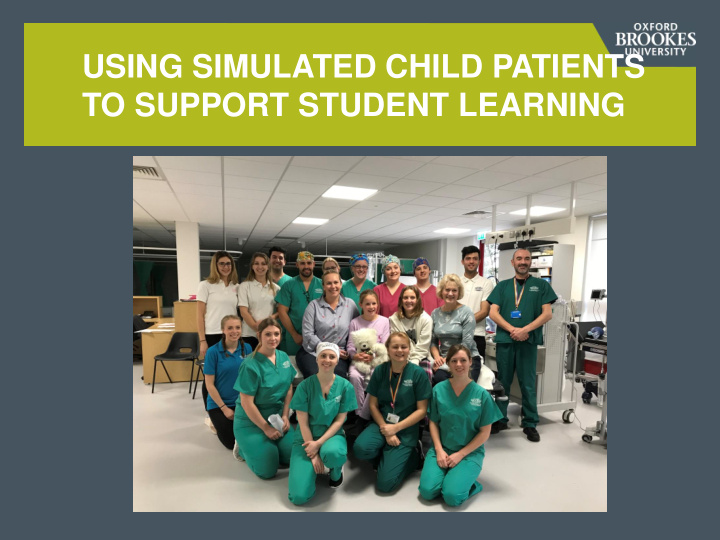



USING SIMULATED CHILD PATIENTS TO SUPPORT STUDENT LEARNING
TALK AIMS - Share some pearls of wisdom and our experiences - Rich teaching tool / resource - Student experience / satisfaction levels are generally high - Overcome the Pitfalls/Barriers - Collaboration & building confidence in using simulated child patients
NMC STANDARDS AND SBE Approved education institutions, together with practice learning partners, must ensure that all students: 3.4 are enabled to learn and are assessed using a range of methods, including technology enhanced and simulation-based learning appropriate for their programme as necessary for safe and effective practice Annexe A: Communication and Annexe B: Nursing procedures relationship management skills https://www.nmc.org.uk/supporting-information-on-standards-for-student-supervision- and-assessment/learning-environments-and-experiences/types-of-learning- experiences/different-learning-opportunities/
OTHER STANDARDS AND GUIDANCE
BIOLOGICAL BASIS OF LEARNING • Orchestrated immersion in complex environment • Relaxed alertness • Active Processing • (Papers and Rogers 2015)
ORCHESTRATED IMMERSION IN COMPLEX ENVIRONMENTS -Appropriately challenging environment -Stretching the learner beyond their current operational or comfort zone (Vygotsky’s zone of proximal development – stretch but connect!) -Must be achievable -LEARNING OBJECTIVES - ? student / faculty
PITCHING THE RIGHT LEVEL
EMOTIONAL LEARNING One’s emotional state during the learning experience influences retention & activation of knowledge. Highly activated states tend to make learning more indelible. Performance is enhanced when the learning & clinical states are similar. The emotional " sweet spot " for simulation and debriefing. Source. Adapted from Russell and Feldman Barrett (1999).
CREATING A SAFE LEARNING ENVIRONMENT Psychological safety Role of Pre-Briefing Basic assumption Fiction contract Transparency Clear learning objectives Debriefing “Learning is the process whereby knowledge is created through the transformation of experience” (Kolb, 1984, p. 38).
WHAT ARE SIMULATED PATIENTS? • The terms standardized patient and simulated patient (SP) are often used interchangeably and refer to a person trained to portray a patient in realistic and repeatable ways. • SPs interact with learners in experiential education and assessment contexts. • SPs can also provide feedback on learner performance from the perspective of the person they portray, which is unique to working with SPs. • As noted in the rationale, SP-based education has grown in size and scope of practice to include many different roles, not just patients • The context in which SPs are working determines the degree of repeatability or standardization (consistency and accuracy) of their behaviour, both within an individual SP’s performance and between SPs portraying the same role. • This behaviour can be seen as part of a continuum. On one end of the continuum, in high stakes assessment, SPs may be trained to behave in a highly repeatable or standardized manner in order to give each learner a fair and equal chance and are often referred to as standardized patients. It is important to note that in this context, SPs are individuals whose behaviour has been standardized. • In formative educational settings, where standardization may not play an important part of the session design, carefully trained SPs are able to respond with more authenticity and flexibility to the needs of individual learners and are referred to as simulated patients.
SIMULATED PATIENTS OR MANIKINS OR TASK TRAINERS
RATIONALE FOR ENGAGING WITH CHILDREN: • United Nations Convention on the Rights of the Child (1989) • Every Child Matters (2003) • The National Service Framework for Children, Young People and Maternity Services (2004) • The review of the NHS by Lord Darzi (2008) All identify the importance of participation by children and young people as a core principle. All state that everyone working with children and young people should have a common set of skills and knowledge and be able to effectively communicate.
5 PRINCIPLES FOR EDUCATING AND USING SIMULATED PATIENTS 1. Preparation Training for the SP 2. Training for role portrayal 3. Training for giving feedback/debriefing 4. Training for completion of assessment instruments (if being used) 5. Reflection on the training process (adapted from Lewis et al 2017)
CHILD SIMULATED PATIENTS-SPECIAL CONSIDERATIONS 1. Should always come with a chaperone (normally a SP as well and can be used in SBE) 2. All students and staff will need to have current DBS 3. Not a readily available-consider using a regional group e.g SimAcademy 4. Need additional support to participate in the debrief. Consider the following approach to obtaining their feedback. What did you: See, hear, smell, touch, feel 5. For example: did you feel as though people were crowding you? Did you hear lots of voices at one time? …….
OVER COMING BARRIERS TO USING SIMULATED PATIENTS 1. Expense 2. Locating child SPs 3. Group size 4. Confidence of facilitators 5. Designing Scenarios
THANK YOU TO: SimComm Academy for providing such highly trained simulated child patients office@simcommacademy.com www.simcommacademy.com Clair Merriman-cmerriman@brookes.ac.uk
Recommend
More recommend